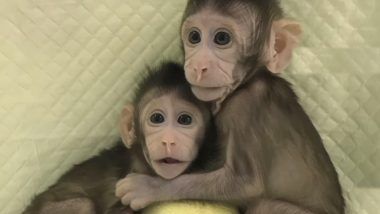The method which created Dolly - the sheep in 1996, has now been successfully used to produce two healthy monkeys. Identical, long-tailed cute little female macaques named Zhong Zhong and Hua Hua were born weeks ago at a laboratory in China. The two are genetically identical, both clones of the same donor culture of fatal monkey cells. The young monkeys are reportedly healthy and currently living in an incubator.
Zhong Zhong and Hua Hua were the result of 79 attempts. The discovery leads to a brave new world of biomedical research and potentially will spark the debate over cloned human beings. Media reports stated that there were lot of efforts taken by scientists who tried and failed to make monkeys, they have undertaken a long road to success. The goal is to create lots of genetically identical monkeys which will eventually be used in medical research. They would be particularly valuable because they are more like humans than other lab animals.
So far, scientists have cloned nearly two dozen kinds of mammals, including dogs, cats, pigs, cows and polo ponies and have also created human embryos with this method. Zhong Zhong was born eight weeks ago and Hua Hua six weeks ago. They are named after the Mandarin term for the Chinese nation and people.
Meet the cloned monkeys Zhong Zhong and Hua Hua
How does this clone method work?
All living beings including animals such as sheep and monkeys too have a bundles of cell called nucleus which contains a copy of their distinct genetic code. Somatic cell nuclear transfer, a technique that involves delicately transferring the nucleus from one animal’s cell into another animal’s egg. Scientists than proceed to chemically prod the egg into developing as if it has been naturally fertilized. If this embryo reaches a certain stage of development, it can than be implant into surrogate. And if the procedure is successful, the surrogate will get pregnant and give birth to an animal that is genetically identical to the nucleus donor.
How is this a big deal?
In 1996, Dolly the sheep became the first mammal cloned using the technique called somatic cell nuclear transfer. Theoretically, this method can produce an indefinite number of clones from a single donor. This lets craft customizable, genetically uniform populations of animals with potential to biomedical research. Scientists so far have produced more than 20 species from cows to rabbits. The Chinese effort marks the first time that non-human primates have been cloned successfully in the same way. This is a big deal because researchers say that the cloning method in this study may apply to other primates such as humans. But the study authors claim that as of now there are no intention of cloning humans.
Is it ethical to make clones?
Kathleen Conlee, Vice President of Animal Research Issues at the Humane Society of the United States was quoted in a media report as saying, “Is this appropriate, to have an animal you can do whatever you want to? It creates a poor dynamic about how we treat animals overall”.
China is a country that have been facing high scrutiny on animal security because it has no comprehensive laws against animal cruelty.
Many biomedical researches insist that primate models are still necessary for studying complex human diseases and disorders. The study authors confirm that their research facilities follow animal-welfare regulations set by the United States National Institutes of Health and that they are very attentive towards the macaque’s welfare.
Scientists will keep watch on Zhong Zhong and Hua Hua, who for now appear to be growing and developing like normal monkeys.
(The above story first appeared on LatestLY on Jan 25, 2018 12:46 PM IST. For more news and updates on politics, world, sports, entertainment and lifestyle, log on to our website latestly.com).













 Quickly
Quickly











